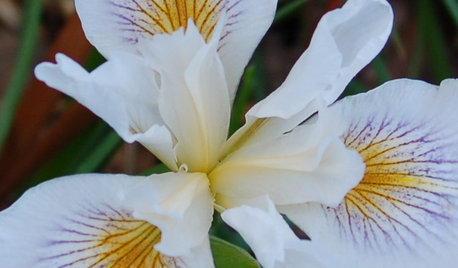The procedure for preparing iris plants for shipment from one garden to another varies according to the iris variety being shipped. There are essentially four basic categories of irises: bearded (bearded species and cultivars, arils, and arilbreds), crested (cristata, tectorum, japonica, etc.), beardless (Siberian, Japanese, Louisiana, etc.), and bulbous (Dutch, juno, reticulata, etc.).
Bearded irises are shipped dry. These irises can be moved at any time during the growing season, though they are traditionally divided about 6 weeks after bloom. It's important to get them replanted into their new garden at least 6-8 weeks before freezing weather to give them time to root in adequately before winter.
Use a spade or fork to dig up your iris clumps and wash them off well with a hose until you have removed all dirt and can easily see where the rhizomes (rzs) are attached to one another. With a sharp knife, cut through the attachments (or you can break them apart with your hands, but a sharp knife will make a smaller, cleaner wound). Inspect the rzs thoroughly. Discard any rhizomes that are soft or mushy or show any other signs of disease, any that do not have viable roots, and any that are just too tiny to bother with. Many folks also discard any rzs that have already bloomed (they will not bloom again, though they may grow additional increases). Remove any dead, spotted, or unhealthy (brown or yellow) leaves, and wipe off any insects on the remaining leaves. Cut the leaf fan back just enough to accommodate the size of your shipping box without having to bend or fold the leaves. Snip off any dead roots but leave the plump roots intact. As a preventative measure to avoid transmitting any plant pests or diseases to your trader's garden, soak the rzs in a solution of 1 part household bleach to 9 parts water for 20 minutes, then rinse in clear water. Dry the leaves and, using a permanent marker, write the name or description of the plant on a single, central leaf. Avoid writing across several leaves or on the outer leaves of a fan. As leaves dry, they tend to separate from each other, and the outer ones shrivel and die.
After you have separated, inspected, cleaned, and labeled your rzs, lay them out in a shady, dry area for a couple days to allow the cut wounds to scab over and the plants to dry thoroughly. It is extremely important to ship only completely dry plants, as any dampness (even moisture retained between the leaves) can result in mold and rot developing in transit. Once your plants are completely dry, pack them loosely into a box using a minimal amount of a breathable and absorbable packing material (excelsior, dry wood shavings, crumpled or shredded newspaper - avoid styrofoam packing materials). Punch holes in the box to allow good air circulation, and your irises are ready to travel to their new home.
Crested irises may be shipped either dry for larger species such as Iris tectorum, or with the rhizomes and roots kept damp for smaller species such as Iris cristata. These irises can be moved at any time during the growing season, but it's probably best to do so immediately after bloom is finished. It's important to get them replanted into their new garden at least 6-8 weeks before freezing weather to give them time to root in adequately before winter.
Use a spade or fork to dig up your iris clumps and wash them off well with a hose until you have removed all dirt and can easily see where the rhizomes (rzs) are attached to one another. Depending on the size of the rzs, you may wish to divide them either into small clumps or individual rhizomes. With a sharp knife, cut through the attachments. Place rhizomes of small crested species into a bucket of water to prevent them from drying out. Inspect the rzs thoroughly. Discard any rhizomes that are mushy or show any other signs of disease and any that do not have viable roots. Many folks also discard any rzs that have already bloomed (they will not bloom again, though they may grow additional increases). Remove any dead, spotted, or unhealthy (brown or yellow) leaves, and wipe off any insects on the remaining leaves. Cut the leaf fan of larger crested species back just enough to accommodate the size of your shipping box without having to bend or fold the leaves. Snip off any dead roots but leave the plump roots intact. Dry the leaves and, using a permanent marker, write the name or description of the plant on a single, central leaf. Avoid writing across several leaves or on the outer leaves of a fan. As leaves dry, they tend to separate from each other, and the outer ones shrivel and die.
After you have separated, inspected, cleaned, and labeled your plants, wrap the rhizomes and roots of smaller crested species in damp (not wet) paper towels or peat moss. Place the wrapped rhizomes and roots in a plastic baggie or plastic wrap, securing snugly around the base of the leaves. Pack the prepared plants loosely into a box using a breathable and absorbable packing material (excelsior, dry wood shavings, crumpled or shredded newspaper - avoid styrofoam packing materials). Punch holes in the box to allow good air circulation. Ship crested irises to arrive as quickly as possible to avoid having the roots and rhizomes of smaller species dry out in transit.
Beardless irises are shipped with the rhizomes and roots kept damp. These irises should be transplanted only in early spring or early fall when air temperatures are moderate. It's important to get them replanted into their new garden at least 6-8 weeks before freezing weather to give them time to root in adequately before winter.
Use a spade or fork to dig up your iris clumps and wash them off well with a hose until you have removed all dirt and can easily see where the rhizomes (rzs) are attached to one another. Depending on the size of the rzs, you may wish to divide them either into small clumps or individual rhizomes. With a sharp knife, cut through the attachments. Place all rhizomes into a bucket of water to prevent them from drying out. Inspect the rzs thoroughly. Discard any rhizomes that are mushy or show any other signs of disease, any that do not have viable roots, and any that are just too tiny to bother with. Many folks also discard any rzs that have already bloomed (they will not bloom again, though they may grow additional increases). Remove any dead, spotted, or unhealthy (brown or yellow) leaves, and wipe off any insects on the remaining leaves. Cut the leaf fan back just enough to accommodate the size of your shipping box without having to bend or fold the leaves. Snip off any dead roots but leave the plump roots intact. Dry the leaves and, using a permanent marker, write the name or description of the plant on a single, central leaf. Avoid writing across several leaves or on the outer leaves of a fan. As leaves dry, they tend to separate from each other, and the outer ones shrivel and die.
After you have separated, inspected, cleaned, and labeled your plants, soak them overnight in a bucket of clean water to make sure they are fully hydrated for their trip to their new home. After soaking, wrap the rhizomes and roots (not the leaves) in a wet paper towel, damp peat moss, or hydrated polymer crystals. Place the wrapped rhizomes and roots in a plastic baggie or plastic wrap, securing snugly around the base of the leaves. Pack the prepared plants loosely into a box using a breathable and absorbable packing material (excelsior, dry wood shavings, crumpled or shredded newspaper - avoid styrofoam packing materials). Punch holes in the box to allow good air circulation. Ship beardless irises to arrive as quickly as possible to avoid having their roots dry out in transit. Upon receipt, beardless irises should be soaked in a bucket of fresh water overnight before planting.
Bulbous irises are shipped dry. Most bulbous irises are handled similarly to tulips or daffodils. Dig dormant, mature bulbs in summer after the foliage has died down. Rinse off all soil and remove dead foliage. Inspect bulbs for signs of disease or insect damage, keeping only healthy bulbs for trading and replanting. Juno irises require a bit of extra care as they have both bulbs and fleshy roots. Care should be taken to dig these irises with the fleshy roots intact and to package them carefully to avoid bruising either bulbs or roots in transit.
Allow bulbs to dry for a couple days before packaging for shipping. Pack them loosely into a box using a breathable and absorbable packing material (excelsior, dry wood shavings, crumpled or shredded newspaper - avoid styrofoam packing materials). Punch holes in the box to allow good air circulation. Bulbs should be replanted in mid to late autumn.













Related Discussions
Should I prepare to plant fruit trees this spring?
Q
How often should I devide bearded iris?
Q
Advice on preparing and mailing TB Iris?
Q
preparing & planting iris tubers?
Q